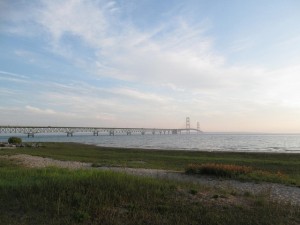Labor Day Bridge Walk is an opportunity for action on Straits oil pipeline

Gov. Rick Snyder will lead about 40,000 people on a five-mile walk across the Mackinac Bridge on Monday, continuing a 57-year old Labor Day tradition.
Also on Monday—as happens every day—23 million gallons of crude oil will cross the Straits of Mackinac just west of the bridge, through a pair of pipelines a couple hundred feet below the surface.
The pipelines are older than the Bridge Walk tradition. They were installed in 1953, the first year of Dwight D. Eisenhower’s presidency, when Patti Page’s “The Doggie in the Window” topped Billboard charts and the U.S. Supreme Court was deliberating whether public school segregation was constitutional.
The kids were crazy for this sort of thing when the Straits oil pipelines were installed.
They are owned by Enbridge, the Canadian company responsible for the worst inland oil spill in U.S. history - the 2010 spill of about a million gallons of tar sands oil into the Kalamazoo River, which is still being cleaned up. The Straits pipelines are older than the one that ruptured in the Kalamazoo spill, but Enbridge has made public very little information on their condition. In July, the state notified Enbridge it needed additional support structures to comply with state regulations.
Enbridge was responsible for more than 1,000 oil spills in the U.S and Canada between 1999 and 2013.
MEC and other groups from the Oil & Water Don’t Mix campaign will be at the Bridge Walk to gather signatures from participants on a petition urging Gov. Snyder to protect the Great Lakes from a disastrous oil spill. (Signing the petition is quick and easy; click here.) We’re asking the governor to immediately open a transparent, public process under the Great Lakes Submerged Lands Act to evaluate the threat posed by the pipelines and determine what actions should be taken to prevent a catastrophe.
And catastrophe is no exaggeration. At any moment, there are a million gallons of oil in the pipelines under the Straits. The National Wildlife Federation and the University of Michigan recently released a series of animations modeling how quickly oil from a ruptured pipeline would spread throughout the region. As you can see below, the animations show that strong, erratic currents in the Straits could cover 50 miles of Lake Huron shoreline with oil while also fouling Beaver Island, Wilderness State Park and other pristine, ecologically rich sites in Lake Michigan.
“If you were to pick the worst possible place for an oil spill in the Great Lakes, this would be it,” according to U-M researcher David Schwab, who created the animation. “The currents are powerful and change directions frequently. In the event of an oil spill, these factors would lead to a big mess that would be very difficult to contain.”
Are you participating in the Bridge Walk? Stop by our tent at the south end of the bridge. We’ll be glad to answer your questions and let you know how you can get involved to help protect the Great Lakes. And remember, you don’t have to walk the bridge to sign the petition. Just click here, and be sure to encourage friends and family to sign on as well.
Thanks, and have a great Labor Day weekend!
###
Photo courtesy Doug Kerr via Flickr.
Browse these next
- Non Gamstop Casino
- Casino Online Migliori Italia
- Non Gamstop Casinos
- Casinos Not On Gamstop
- Casino Online Non Aams
- Non Gamstop Casino UK
- Best Non Gamstop Casinos
- Best Non Gamstop Casinos
- Online Betting Sites Not On Gamstop
- Non Gamstop Casino UK
- UK Casinos Not On Gamstop
- UK Casino Not On Gamstop
- Gambling Sites Not On Gamstop
- Casinos Not On Gamstop
- Non Gamstop Casino
- Casino En Ligne Meilleur Site
- Casino En Ligne Meilleur Site
- Casino En Ligne France
- Non Gamstop Casino Sites UK
- Top UK Casino Sites
- Best Online Casinos Uk
- Lista Casino Online Non Aams
- Casinos Not On Gamstop
- Casino Online Non Aams
- Casino Non Aams
- Meilleur Casino En Ligne Belgique
- Siti Scommesse Bitcoin
- Casino En Ligne Sans Kyc
- Casino En Ligne Nouveau Bonus
- 비트코인 카지노



Comments are closed.